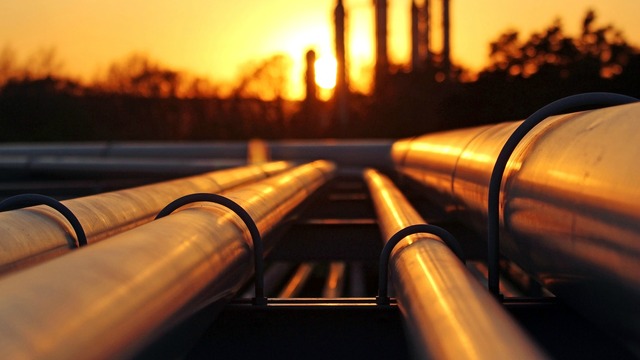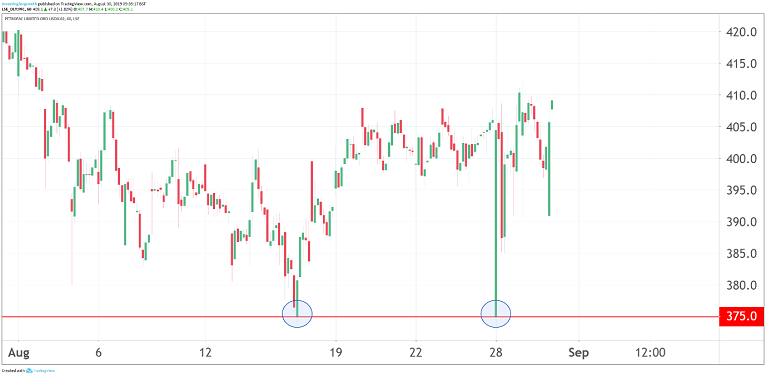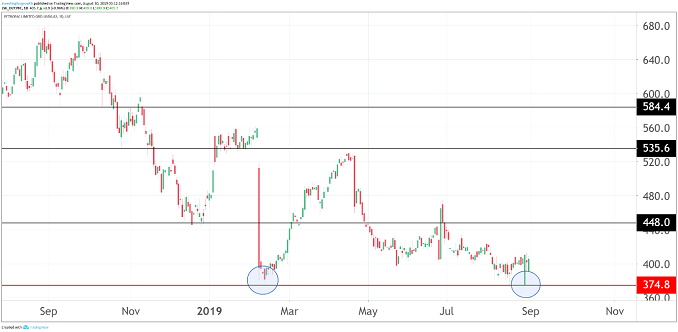Stockwatch: Should you own this controversial stock?
This stock offers an 8% yield, but risk has increased and we don't know when an overhang will clear.
30th August 2019 10:08
by Edmond Jackson from interactive investor
This stock offers an 8% yield, but risk has increased and we don't know when an overhang will clear.

Shares in mid-cap oil industry services group Petrofac (LSE:PFC) initially dipped around 6% to 375p in response to latest interim profit figures and 10% reduction in the crucial "backlog" (or work-in-progress).
However, they promptly recovered to end results day up 1% at 410p.
In the short term this behaviour re-affirms a bottom at around 375p, a level which the stock has visited a few times in August: in long-term context this marks a 10-year low which begs the question whether on a focused "technical" view the chart is consolidating a support point.
But how secure is this as management guides for lower revenues in 2020 "reflecting low new order intake in recent years"?

Source: TradingView Past performance is not a guide to future performance
I've favoured Petrofac as a special situation from 400p: sentiment being hit from 950p briefly as low as 350p in April 2017, on news of a Serious Fraud Office (SFO) investigation into bribery – albeit industry-wide than specific to Petrofac.
From a "special sit" angle, the history of stocks caught up in bribery is an over-reaction to the news then a recovery according to how strong is its market share.
So, Petrofac rallied 65% to over 660p by September 2018 before falling with the wider market to 450p by year-end.

Source: TradingView Past performance is not a guide to future performance
2019 has turned trickier as cyclical fears creep in
I believe recent stock volatility reflects the SFO inquiry dragging on, which now conflates with industrial services stocks turning down generally. Petrofac's early 2019 rebound to 530p was kyboshed with a 29% fall to this apparent 375p chart support level, after the company's former global head of sales admitted 11 counts of bribery from 2012 to 2015 (This was not announced by RNS).
The market is anyway prepared if allegations of complicity by Petrofac are proven, leading to a substantial cash fine. It could potentially be enough to compromise a circa 33p equivalent projected dividend that's currently propping the stock. The implied 8.2% yield is covered over twice by projected earnings and cash reserves.
No charges have been tabled against anyone else or any Petrofac company; and so last April I suggested a speculative 'buy' stance remained despite the SFO investigation dragging on and raising the risk of government agencies taking a cleaner line not to renew or award contracts.
Petrofac's latest interims explain a 19.4% fall in underlying net profit to $154 million (£126 million) on grounds of higher overheads impacting margins – this can typify the late stage of a business cycle - and higher taxation.
More critical perhaps are factors affecting demand: oil & gas-field services tend to be highly sensitive to energy prices where on a supportive view, OPEC appears better-organised as a cartel (why petrol prices have risen); but beware also how oil prices fall whenever recession fears strike markets, anticipating lower demand.
| Petrofac - financial summary | |||||
|---|---|---|---|---|---|
| year ended 31 Dec | 2014 | 2015 | 2016 | 2017 | 2018 |
| Turnover ($ million) | 6,241 | 6,844 | 7,873 | 6,395 | 5,829 |
| Operating profit ($ million) | 221 | -252 | 186 | 104 | 159 |
| Net profit ($ million) | 120 | -349 | 1.0 | -29 | 64 |
| Reported EPS ($) | 0.4 | -1.0 | 0.0 | 0.1 | 0.2 |
| Normalised EPS ($) | 0.8 | -0.6 | 0.8 | 1.2 | 1.3 |
| Operating cash flow/share ($) | 1.9 | 2.0 | 1.9 | 1.2 | 1.4 |
| Capex/share ($) | 1.4 | 0.5 | 0.5 | 0.3 | 0.3 |
| Free cash flow/share ($) | 0.5 | 1.5 | 1.4 | 0.9 | 1.1 |
| Dividend/share ($) | 0.7 | 0.7 | 0.6 | 0.1 | 0.4 |
| Net assets/share ($) | 5.4 | 3.6 | 3.2 | 2.7 | 2.1 |
| Source: Histroric Company REFS and company accounts |
Reality mismatch between RNS and other reporting
These interim results say recent new order intake "has been impacted by recent challenges in Saudi Arabia and Iraq", the operating review does not elucidate - nor did a 25 June trading update when the same words were used, or in the 28 February results for 2018.
Separately, however, when last writing in April I noted the Iraq Oil Report said Baghdad's oil ministry had ended negotiations with Petrofac on grounds of the bribery scandal – though wasn’t affirmed by any Petrofac regulatory announcement.
I suggested:
"The potential game-changer for equity risk is whether this apparent decision spreads in the Middle East, i.e. the market's initial caution in 2017 was correct and it has just taken longer to manifest with regard to fundamentals."
So it's not good how there's a mismatch between Reuters reporting on 28 August: "The company said in June it had lost out on $10 billion worth of contracts globally due to investigation by the SFO" versus the text of its announcement which read:
"We continue to maintain excellent client relationships in all of our markets, although new order intake reflects our recent challenges in Saudi Arabia and Iraq."
Petrofac currently says a 10% reduction in its backlog to $8.6 billion over six months reflects not just low new order intake but also progress with existing projects. OK, but the stock quite rationally is left priced both for uncertainty over Petrofac's reputation affecting new business, plus risks to the global economy and oil prices.
29% increase in total debt is a concern
The end-June balance sheet shows long-term debt up 79% to $673 million, although I'd include lumpy "other financial liabilities" which are up 5% to $358 million long-term, also those short-term up 12% to $156 million despite short-term debt down 3% to $251 million.
Altogether, such liabilities total $1,438 million, up 29% on $1,116 million in June 2018, relative to fairly constant net assets of $1,059 million with low goodwill/intangibles of $141 million. So, while it's not a balance sheet that groans, it is hardly the change you want to see if the global economy is slowing and Petrofac may have to absorb a hefty SFO fine.
In terms of serviceability, the net interest charge was $23 million in this first half, covered 9.5 times by underlying operating profit of $218 million, implying space for finance costs to rise and profit to further fall, though again not ideal.
Also, trade payables have advanced 16% to $1,113 million versus trade receivables down 3% to $1,394 million. Sceptics may wonder if Petrofac has massaged profit by any delay to creditors, although the payables/receivables ratio is overall respectable.
- Income hunters can find great funds on ii's Super 60 recommended list of investments
- Stockwatch: A possible turnaround and 6.7% dividend yield
Increase in period-end cash allows some comfort
Reading across to the interim cash flow statement, the same $86 million went out for dividends during the period yet overall, cash rose to $917 million at end-June versus $705 million in 2018. As is often the case in company accounts there's a balance sheet mismatch where it reports $993 million and $726 million respectively, but at least this trend is reassuring versus Petrofac's debt hike.
It provides cushioning to absorb a mid-scale SFO fine, though I recall speculation of $1 billion-plus equivalent as also possible.
Alternatively, the longer SFO investigations drag on – then to assert a swingeing fine – the more it loses respect when effectively punishing existing managers/shareholders – longer may mean lower risk.
Divisions show no real signs of cyclicality
Performance is mixed albeit demand appears sustained. Engineering & construction has enjoyed $1.6 billion new order intake this year - Algeria, Oman and the Netherlands show revenue up 2% to $2.3 billion, "principally reflecting project phasing..." though the net margin eased to 6.5% and net profit by 16% to $148 million.
Engineering & production services received $0.4 billion awards chiefly in the UK, Oman, UAE and Iraq, equating to $0.4 billion reported revenue, up 4%. However, margin eased to 5.1% for net profit down 15% to $23 million.
Integrated energy services were more encouraging – if smallest of the three divisions – despite asset sales distorting like-for-like reported numbers into losses. Otherwise, revenue rose 5% to $99 million with net profit up 147% to $7 million.
Accordingly, it's not as if these results show demand affected by economic slowdown, but the stock may be falling in anticipation of such rather than the reality.
'Buy' stance is thus tested
I'm in the invidious position now where reasons for adopting a 'buy' stance on Petrofac, contra the SFO-related fears, have not manifestly changed, nor do these results show cyclical worries on the demand side.
Some knock-on effect to the bribery affair was inevitable and could be transient.
Unless a swingeing fine cancels the dividend an 8%-plus yield is now asserting a support level.
Alternatively, oil prices could fall in a global slowdown. So, overall risk has likely increased and conservative investors should avoid, certainly until the SFO matter clears.
However, a fine could conceivably boost the stock, especially if nothing manifests against the company. For risk-tolerant investors my stance remains: Buy.
Edmond Jackson is a freelance contributor and not a direct employee of interactive investor.
These articles are provided for information purposes only. Occasionally, an opinion about whether to buy or sell a specific investment may be provided by third parties. The content is not intended to be a personal recommendation to buy or sell any financial instrument or product, or to adopt any investment strategy as it is not provided based on an assessment of your investing knowledge and experience, your financial situation or your investment objectives. The value of your investments, and the income derived from them, may go down as well as up. You may not get back all the money that you invest. The investments referred to in this article may not be suitable for all investors, and if in doubt, an investor should seek advice from a qualified investment adviser.
Full performance can be found on the company or index summary page on the interactive investor website. Simply click on the company's or index name highlighted in the article.
Disclosure
We use a combination of fundamental and technical analysis in forming our view as to the valuation and prospects of an investment. Where relevant we have set out those particular matters we think are important in the above article, but further detail can be found here.
Please note that our article on this investment should not be considered to be a regular publication.
Details of all recommendations issued by ii during the previous 12-month period can be found here.
ii adheres to a strict code of conduct. Contributors may hold shares or have other interests in companies included in these portfolios, which could create a conflict of interests. Contributors intending to write about any financial instruments in which they have an interest are required to disclose such interest to ii and in the article itself. ii will at all times consider whether such interest impairs the objectivity of the recommendation.
In addition, individuals involved in the production of investment articles are subject to a personal account dealing restriction, which prevents them from placing a transaction in the specified instrument(s) for a period before and for five working days after such publication. This is to avoid personal interests conflicting with the interests of the recipients of those investment articles.